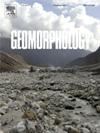Shoreline responses to rapid water level increases in Lake Michigan
IF 3.1
2区 地球科学
Q2 GEOGRAPHY, PHYSICAL
引用次数: 0
Abstract
High-resolution multispectral satellite imagery was utilized to quantify shoreline recession at eleven beaches around Lake Michigan during a record-setting water level increase between 2013 and 2020. Shoreline changes during this period ranged from 20 m to 62 m, corresponding to 52–95 % of the initial beach widths. Average estimated shoreline erosion across all beaches varied from 1 % to 75 % of the observed changes, with the remainder attributed to inundation. Significant correlations were found between shoreline erosion and wave-related factors, including offshore wave power, offshore bathymetric slope, storm energy, and potential alongshore sediment transport divergence. In contrast, parameters related to cross-shore transport, such as dimensionless fall velocity, exhibited weak correlations. Additionally, the results underscore the importance of distinguishing between immediately reversible changes (inundation) and morphological changes that could be reversible over longer timescales, when assessing the impact of rising water levels. The findings also suggest that in addition to waves playing a key role in regulating shoreline changes, alongshore sediment transport processes may play a more crucial role in beach erosion during significant water level increases than cross-shore processes, challenging traditional models of beach adjustment to rising waters.
密歇根湖的海岸线对水位快速上升的反应
在2013年至2020年创纪录的水位上升期间,利用高分辨率多光谱卫星图像量化了密歇根湖周围11个海滩的海岸线衰退。在此期间,海岸线的变化范围为20 ~ 62 m,相当于初始海滩宽度的52 ~ 95%。所有海滩的海岸线侵蚀平均估计占观测到的变化的1%至75%不等,其余归因于淹没。海岸线侵蚀与海浪相关因子之间存在显著的相关性,包括近海波浪能、近海水深坡度、风暴能量和潜在的沿岸沉积物输运差异。相反,与跨岸运输相关的参数,如无量纲下降速度,表现出弱相关性。此外,研究结果强调了在评估水位上升的影响时,区分立即可逆的变化(淹没)和可能在更长时间尺度上可逆的形态变化的重要性。研究结果还表明,除了波浪在调节海岸线变化中发挥关键作用外,在显著的水位上升期间,沿岸沉积物运输过程可能在海滩侵蚀中发挥比跨岸过程更重要的作用,这对海滩适应上升水位的传统模型提出了挑战。
本文章由计算机程序翻译,如有差异,请以英文原文为准。
求助全文
约1分钟内获得全文
求助全文
来源期刊

Geomorphology
地学-地球科学综合
CiteScore
8.00
自引率
10.30%
发文量
309
审稿时长
3.4 months
期刊介绍:
Our journal''s scope includes geomorphic themes of: tectonics and regional structure; glacial processes and landforms; fluvial sequences, Quaternary environmental change and dating; fluvial processes and landforms; mass movement, slopes and periglacial processes; hillslopes and soil erosion; weathering, karst and soils; aeolian processes and landforms, coastal dunes and arid environments; coastal and marine processes, estuaries and lakes; modelling, theoretical and quantitative geomorphology; DEM, GIS and remote sensing methods and applications; hazards, applied and planetary geomorphology; and volcanics.
 求助内容:
求助内容: 应助结果提醒方式:
应助结果提醒方式:


